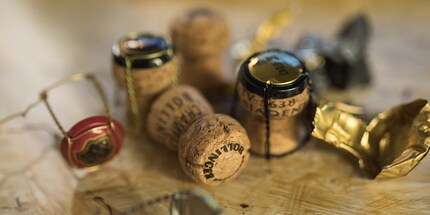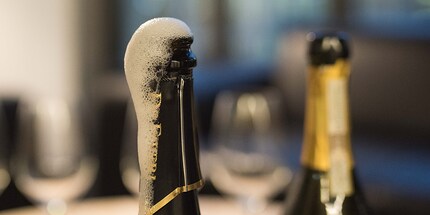
Background information
Knowing your wine: appellations as a quality feature
by Tanja Lehmann

Crack open the bubbly! Many of us raise our glass of sparkling wine to celebrate Christmas or the New Year. How come sparkling wine is such a popular drink? And what’s the difference between Champagne and Prosecco? Read on to find answers to these and more questions.
I used to think all sparkling wines were similar. How wrong I was. I now know that, although they all sound fancy, there are large differences in quality and price. Why is Champagne so much more expensive than other sparkling wines? And what’s the difference between Champagne and Prosecco? I’ve decided to get to the core of these questions. To wrap up my research, I tested two kinds of Champagne and two kinds of Prosecco to find out if I could notice a difference.
Fermentation produces carbon dioxide and alcohol, which is why all wines turn into sparkling wines at a certain point in time. Most of the time, the carbon dioxide is released, but some wines taste better when they're fizzy, so the carbon dioxide needs to be kept within the bottle. Special methods have been developed to do this, for example transferring the last part of the fermentation process into pressure-tight containers.
One of the most famous methods was developed in the Champagne, a region in the north-east of France. This «méthode traditionelle» is still widely used today to make high-quality sparkling wine, as it produces a unique combination of crispness and richness. To make less sophisticated wines, a simpler process is applied or the second fermentation is skipped. This is what the classic method from the Champagne region looks like.
Step 1: The base wine
Base wines are typically dry, low-alcohol white wines made with barely ripe, red and white grapes. Some winemakers use rosé wine or even red wine.
Step 2: Adding sugar and yeast
The base wine is filled into bottles, sugar and yeast is added and the bottle is closed. The same applies to Prosecco; however, large tanks are used instead of bottles.
Step 3: Second fermentation
The yeast turns the sugar into carbon dioxide and alcohol. This is why the wine is sparkling.
Step 4: Lees
After fermentation, the yeast settles as sediment (lees). This gives the sparkling wine a note of bread and a fuller texture. With champagne, the sediment is in the bottle and a process called «riddling» is applied, in which the bottles are twisted to shake the sediment loose. This gives the wine more bread notes. With Prosecco, this happens in large tanks and the yeast ends up at the bottom of the tank. There's no twisting and stirring involved, so there's less contact between the yeast and the liquid. As a result, the yeast notes in Prosecco are much weaker, often not noticeable at all.
Step 5: Disgorgement
Sparkling wine is matured for a period of six months up to ten years. When completed, the sediment, that’s packed into the bottleneck, needs to be removed. To do this, the bottle necks are frozen, opened and the frozen plug of sediment taken out. With Prosecco, the wine is filtered into pressure-tight containers during decanting. This is where, with the second fermentation, the famous light bubbles come from. The production of sparkling wine takes at least 30 days and is completed with the fermentation being stopped by lowering the temperature. The residual sugar is retained, as it adds to the wine's balance and harmony.
Step 6: Top up and sugar
After disgorgement, Champagne bottles are topped up with wine and a bit of cane sugar to balance the dryness of the wine. When producing rosé Champagne, red wine is used in this step.
Prosecco is filled into bottles and more carbon dioxide and sugar is added.

First of all, the base wine has an impact on what the result tastes like. Further, as Champagne is matured for a longer time and has more contact with the yeast, it has a more intense bread note. Experts call this the «note of brioche». Champagne also has a more aromatic, intense and complex flavour. Prosecco is sweeter than Champagne, as it’s not matured as long and the sugar doesn’t decompose as much. It also has less complexity. Overall, it takes more time to make and mature Champagne, which is the main reason why it’s more expensive than Prosecco.
What’s important to know about both sparkling wines is that their specific geographical indications are protected; Champagne may only be labelled as such if it was produced in the French region of Champagne. Read more about this here:
Are you wondering if you’d taste the difference? So did I, so I decided to compare two types of Champagne and two types of Prosecco. I was advised to start with Prosecco, so I did. These are the sparkling wines I tested:
Champagne
Prosecco


Villa Sandi Prosecco Valdobbiadene Superiore DOCG Extra Dry
1 x 75 cl
My verdict: Prosecco
In my opinion, the Villa Sandi Proescco is fizzier, sweeter and has a fruitiness with notes of pear and peach. The De Faveri Prosecco has fine bubbles and refreshing citrussy notes. If I was going to buy a bottle, I’d go for the De Faveri; the Villa Sandi is too sweet for my taste.
My verdict: Champagne
Now to the Champagne. I begin with the Jacquart, a Champagne I’ve tasted before and am eager to try again. It has fine bubbles and I can taste notes of honey and fruit; this Champagne tastes delicate and not too sweet. It has subtle bread notes and a good acidity – a great combination for someone like me who doesn’t have a sweet tooth.
The Bollinger has an intense smell and a taste that reminds me of the tiny apples in my neighbour’s garden. There’s a distinct vanilla flavour, resulting from the oak barrel it matured in. The bread note is more intense than with the Jacquart Champagne, combined with a subtle fruity flavour with notes of pear and blossom.

First off, the two look different: Champagne has an intense gold colour while Prosecco is paler. I decided to compare the more subtle Champagne with the more subtle Prosecco, which provided interesting insights.
Jacquart vs Villa Sandi: When comparing the two, the Prosecco can’t compete with the Champagne. The Jacquart is much more intense, making the Villa Sandi taste very simple.
Bollinger vs De Faveri: This comparison is interesting. All I can say is: When compared with the Bollinger, the De Faveri tastes like water.
There really is a difference and even if you’re not an expert, you’ll notice the additional complexity Champagne offers. Nevertheless, Prosecco is also good. At the end of the day, it’s a question of taste; I wouldn’t say Prosecco is more popular because it’s sweeter. Champagne, although it contains less sugar, can have a more intense fruity flavour. Personally, I recommend the Jacquart Brut.

Friends, family, cats and good wine are my lifeblood.
Interesting facts about products, behind-the-scenes looks at manufacturers and deep-dives on interesting people.
Show all